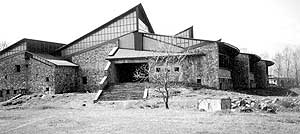 It's taken nearly a decade, but Nepal's mountain museum is taking final shape. At least the first phase is, a cavernous structure designed to house the Hall of Himalayas, the Hall of International Mountains and the Hall of Expeditions.
It's taken nearly a decade, but Nepal's mountain museum is taking final shape. At least the first phase is, a cavernous structure designed to house the Hall of Himalayas, the Hall of International Mountains and the Hall of Expeditions. Flying into Pokhara, the museum is impossible to miss from the air. A massive frame of steel, concrete beams, its unique shape seems to mimic the Annapurna in the backdrop. A complex structure, the roof fans out to resemble the mountains.
While the architecture is impressive, museum experts are concerned that the collection might fall short. "The concept of the mountain museum is great but there's no collection," says Jal Krishna Shrestha, director of the Patan Museum. A long time-member of the Nepal Mountaineering Association, which has been the driving force behind the musuem, Shrestha is working hard to put together a temporary collection for the initial launch on 29 May this year, the International Year of Mountains and the first part of the Destination Nepal campaign. (See "Pokhara's new museum piece" #7) Although this is only a soft opening, NMA officials are expecting some big names to attend, including French climber Maurice Herzog, the first person on Annapurna, and former Japanese prime minister Ryutaro Hashimoto.
And while alpine clubs from around the world have offered to loan this museum their exhibits, to offset Nepal's own deficient collection and lack of funds to buy or collect memorabilia, this may not be the perfect solution. The mountain exposition in Salzburg, Austria preferred Nepal as a first choice to have their expo but the cost of the exhibition, transportation till Pokhara and the installment costs $2 million. "We can't afford that," says NMA president Tashi Jangbu Sherpa. "Even if the expo were brought to Nepal, it would only fill a corner of the hall, which is massive. The museum is an ambitious project, and that is why we plan to open it in phases."
For the soft opening, an exhibition of various ethnic groups, exhibits from local climbers, and photographs will be on display. The NMA also hopes to have a festival of mountain films in the audio-visual hall.
But even though the exhibits come May will be fairly bare bones, there are some impressive names assisting in their preparation. "Various experts will be preparing scripts on different topics so we can put up a temporary exhibition in May," says Shrestha, who is also the convenor of the mountain museum. While Shrestha will be responsible for explaining the vision of the museum and what exactly it hopes to showcase, Dr Harka Gurung will prepare the script for mountain history, Tashi Jangbu Sherpa, president of the NMA, will prepare exhibits of mountaineering equipment, Dr TB Shrestha will prepare the script for the botany collection, and Dr Ganesh Gurung will be working out how to display the wealth of anthropological detail in the mountains. After the formal opening, which is slated for May 2003, the 50th anniversary of the first ascent of Mt Everest and the second part of the Destination Nepal campaign, the museum's permanent exhibits will include selections from past exhibitions, geological specimens, archival photographs, satellite maps and other paraphernalia.
About time, say mountain enthusiasts, who have been waiting in anticipation since 1993. The project has been plagued with setbacks, financial troubles and bickering. "Sometimes you have the money, the equipment, the support, everything, but owing to technical hitches, there's always some delay. This is Nepal-things still take forever," says an NMA official. The dream of former NMA president, the late Dawa Norbu Sherpa, work on the museum came to a standstill in 1997 after Norbu's death. Suddenly missing Norbu's vision and fundraising skills-he managed to collect funds from well-wishing alpine clubs around the world, particularly from Japan, to get the museum off the ground-the NMA was forced to postpone the museum's scheduled opening during Visit Nepal Year 1998 and aim for a soft opening in 2002.
The Rs 300 million museum is the pet project of the NMA, which has already spent Rs 51 million on the building, with funds mostly derived from income by levying fees on medium sized trekking peaks (between 5,555 m and 6,654 m) in the country. Phase II and III of the museum, are still at the blueprint stage, and a new architect will be replacing the initial consortium to cut down on costs. For museum expertise, the NMA has also managed to rope in a Japanese museologist, a volunteer from JICA, to help with the museum come April. The museum is expected to get visitors from outside, but is designed primarily to make Nepalis more aware of their mountain environment.
But now that the museum building is nearing completion, there are other concerns. Although the museum, designed by a consortium of architects from Kathmandu-based Sanday Kentro Associates and Narendra Pradhan and Associates, is visually stunning, observers say it has its shortcomings. "Access to the museum's location and access to the main entrance is difficult," says an observer who recently visited it. There is also concern that urbanisation in the area will block the view of the Annapurna, now clearly visible from the building. NMA officials admit that some "facelifts" will be required in the future, and have roped in architect Shankar Rimal to help with changes.


